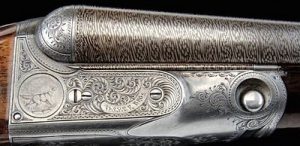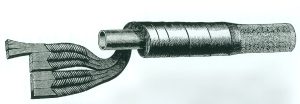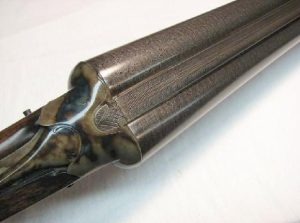Are Damascus Shotgun Barrels Safe?
Damascus barrels trace their roots back to the Middle Ages, primarily in the city of Damascus, Syria, known for its skilled metalworkers. The original purpose of the Damascus technique was to create strong, flexible swords, but this technique was later employed in the manufacture of shotgun barrels. Notable for their remarkable aesthetic appeal, Damascus barrels, also known as “twist” barrels, were popular until the late 19th century when modern steel barrels began to replace them.
The name “Damascus” originates from the intricate patterns on the barrels that resemble those on Damascus swords. The technique involves layering different types of steel or iron, which are then twisted and folded multiple times to create a unique pattern. This labor-intensive process is a testament to the high level of craftsmanship in an era before the advent of modern machinery.

The popularity of Damascus barrels started to wane in the late 19th and early 20th centuries. This was due to advancements in smokeless powder and the invention of modern steel barrels that boasted stronger, more consistent builds. While they are less prevalent today, Damascus barrels still hold historical significance and are prized by collectors and shooting enthusiasts for their beauty and craftsmanship.
Analyzing the Construction and Material of Damascus Barrels
Understanding the construction of Damascus barrels requires appreciating the skill and labor that went into their creation. The process involved forging two or more different kinds of steel or iron into long, narrow rods. These rods were then heated, twisted together, and hammered into a flat ribbon. This ribbon was then wrapped around a mandrel and hammer-forged into a seamless tube. This labor-intensive process was repeated several times to attain strength and the characteristic pattern.
The materials used in Damascus barrels could vary, but typically it involved a mixture of iron and steel. The choice of materials was significant as it influenced the barrel’s strength, flexibility, and ultimately, its quality. The various components were chosen to create a barrel that could withstand the pressures of firing while maintaining its structure.

The beauty of the Damascus barrel lies in its unique pattern. Each barrel bears a unique design, a testament to the craftsmanship of the maker. These patterns, however, are not just for aesthetics. They are indicators of the intricate process of layering, twisting, and folding that gives the Damascus barrel its strength and flexibility.
Assessing the Safety Concerns of Damascus Shotgun Barrels
Despite their rich history and beauty, Damascus barrels have been a subject of safety concerns. One of the primary concerns is their ability to withstand the pressures of modern ammunition. Damascus barrels were designed during the era of black powder, which generates lower pressures. Modern smokeless powder, on the other hand, generates much higher pressures, which could exceed the safety limits of a Damascus barrel.
Moreover, these barrels are prone to rust and corrosion, which can significantly weaken them. In some cases, this corrosion is not visible from the outside, posing a risk when the shotgun is fired. In addition, the quality of a Damascus barrel can greatly vary, depending on the skill of the maker and the type of materials used.

Determining the safety of a Damascus barrel is challenging due to their age. Many of these barrels are well over a century old. Time and use can degrade the barrel, creating unpredictability when it comes to firing. Therefore, firing a Damascus barrel shotgun, especially one that has not been thoroughly inspected, could prove hazardous.
Guidelines for Safe Use and Maintenance of Damascus Barrels
If you own a Damascus barrel shotgun, or are considering acquiring one, safety should be your primary concern. It is highly recommended that you have the barrel inspected by a qualified gunsmith before firing. They can examine the barrel for any signs of damage, corrosion, or other potential safety issues.
If the barrel is deemed safe to fire, it’s suggested to only use black powder ammunition. As previously mentioned, Damascus barrels were designed for black powder, which generates lower pressures. Using modern smokeless powder can put excess stress on the barrel and increase the risk of an accident.
Regular maintenance is also crucial for Damascus barrels. They should be cleaned and oiled regularly to prevent rust and corrosion. This not only keeps the barrel in good condition but also helps to maintain its aesthetic appeal. Remember, though, that no matter how well you maintain a Damascus barrel, it should still be regularly checked by a professional for safety.
While Damascus shotgun barrels hold historical significance and are a testament to the craftsmanship of a bygone era, they come with certain safety concerns. These barrels were not designed for modern ammunition, and their strength and durability can vary greatly. If you own or are considering buying a Damascus barrel shotgun, it’s essential to have it inspected by a professional and adhere strictly to safety guidelines.
# # #


Comments